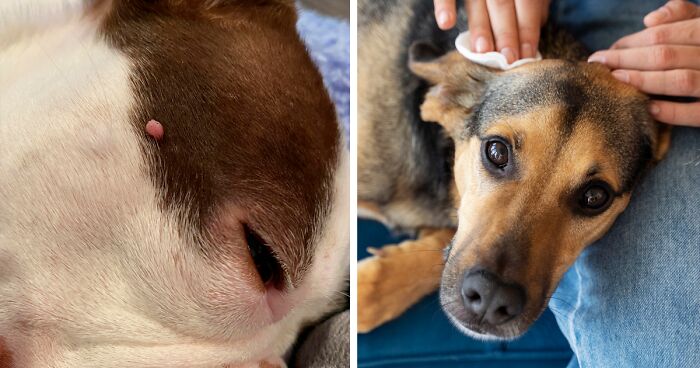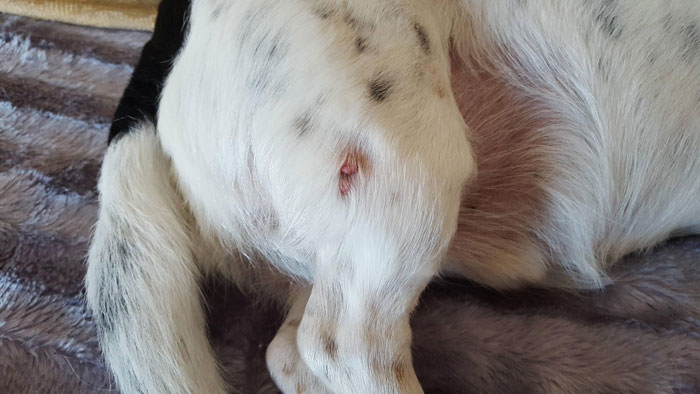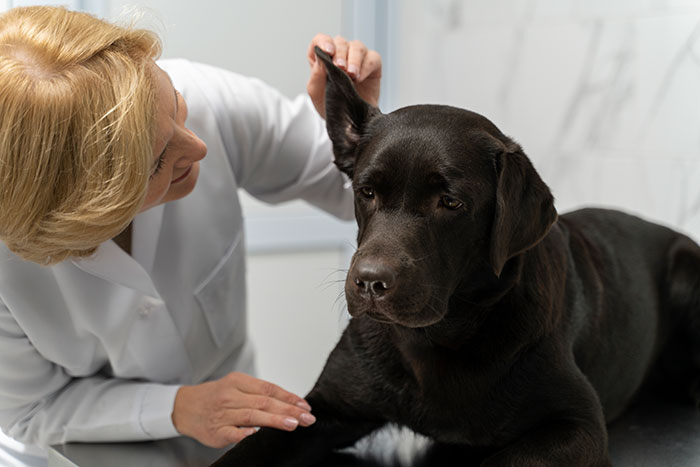Disclaimer: Please refer to the information in this article as a guide only. If you are worried about your pet’s health or behavior, it’s best to contact your veterinarian.
Skin tags on dogs are benign growths that can appear at any age and are usually harmless. However, it’s crucial to understand how to identify and treat these growths properly to prevent any discomfort or future complications.
In this comprehensive guide, I’ll share professional insights and provide you with step-by-step instructions on how to remove skin tags on dogs. Let’s dive into the world of dog skin tags together, understanding their cause, identification, and treatment.
The information provided herein is for informational purposes only. Please refer to our disclaimer for more details..
What Causes Skin Tags On Dogs?
Image credits: JCC87
Skin tags are small, fleshy growths that protrude from the skin’s surface. They can appear in various sizes and shapes and are commonly found in areas with skin folds. These growths are usually harmless and non-cancerous, causing minimal irritation to your furry friend.
Dog skin is more prone to fibrous tags due to the constant rubbing and friction of skin folds. Additionally, genetics, old age or underlying health conditions can increase the likelihood of skin tag development.
While the exact cause of this condition is unknown, they are believed to be a result of skin rubbing against skin or clothing, collars etc. This rubbing causes local irritation in epidermis outer skin layer, leading to the formation of skin tags.
Dogs with skin folds, such as pugs, bulldogs are more susceptible to developing skin tags due to the buildup of moisture and friction in those areas. However, in general, dog skin tag originates form hyperplasia or uncontrolled growth of fibrovascular cells of any breed in old age.
Identifying Skin Tags on Dogs
Identifying skin tags on dogs is an essential step in managing their skin health. These skin growths are usually harmless, but if left untreated, they may cause inflammation and discomfort to your furry friend.
A skin tag typically appears as a small, fleshy pedicle that seems to be attached to the skin by a stalk. These pedicles are often found in areas with skin folds, such as the neck, armpits, and underbelly.
| Sign | Description |
| Size | Are usually small in size, but they can grow larger over time. |
| Color | Typically, are the same color as your dog’s skin, sometimes resembling ticks without legs. |
| Texture | These are usually soft to the touch and moveable. |
| Irritation | These can be itchy, if your dog scratches or chews at them, they may become red and inflamed. |
If you notice any changes in size, shape, color, or if your dog seems to be experiencing discomfort, it’s important to consult a veterinarian to ensure that the growth is indeed a skin tag and not a more serious condition this will help you identify and distinguish skin tags from other similar-looking growths, such as papilloma, warts, or cancerous tumors.
Treatment Options for Skin Tags on Dogs
Once you have confirmed that your dog has a skin tag, it’s important to consider the most suitable treatment option. While most skin tags are benign and non-cancerous, they may still cause discomfort or skin infection to your pet. One of the most common methods of removal is surgical removal, which involves cutting the skin tag off with a scalpel or scissors. This procedure is usually performed under local anesthesia to minimize any pain or discomfort for your dog.
If your dog has a large benign peduncle or multiple lesions, your veterinarian may recommend using cryotherapy or laser therapy instead. Cryotherapy involves freezing the skin tag with liquid nitrogen, while laser therapy involves using a laser to burn off the overgrown tissue. Both these methods are minimally invasive and you may need repeated sessions depending on the size and location of lesions.
It’s important to note that one must be able to differentiate skin tags from other skin problems. For example, papilloma refers to viral growths that resemble skin tags but can spread to other parts of your dog’s body. If you’re unsure about the nature of your dog’s skin tag, consult your veterinarian for a professional diagnosis.
Preventing Skin Tags on Dogs
Image credits: freepik
If you are a pet owner, you know how important it is to keep your furry friend healthy and happy. Part of that responsibility includes taking care of their skin, which can be prone to various skin lesions and irritations. While you may not be able to eliminate the risk of skin tags entirely, there are steps you can take to prevent them from occurring.
Ensure a Proper diet for healthy dog skin
A balanced diet can go a long way in maintaining your dog’s overall health and minimizing the likelihood of skin tag development. Ensure that your pet’s diet includes essential nutrients like omega 3 and 6 fatty acids, vitamins like Vitamin A and E, and minerals like Zinc that are needed for healthy skin.
Regular Check-Ups
Regular veterinary check-ups are crucial in identifying any skin issues early on and treating them before they become a more significant problem. Your veterinarian can also provide you with specific advice and guidance on how to care for your dog’s health and prevent skin issues from occurring.
In this last section, we will be answering the Frequently asked questions from pet owners:
Can You Remove Skin Tags on Dogs at Home?
While I always recommend consulting a veterinarian for skin tag removal, some benign and small skin tags can be safely removed at home. It’s important to note that larger or irritated skin tags should only be removed by a professional.
If you’re considering removing a skin tag on your dog at home, it’s crucial to keep their safety in mind. Make sure to follow proper hygiene by washing your hands and sterilizing any tools you may use, such as scissors or tweezers, with rubbing alcohol.
Here are the steps to safely conduct this procedure:
- Prepare the area by cleaning and disinfecting it by rubbing 70% alcohol or hydrogen peroxide.
- Use a pair of sterilized scissors or nail clippers to cut the skin tag at the base, where it meets the skin. Make sure not to cut too close to the skin to avoid causing bleeding and pain.
- If the skin tag has a stalk, use sterilized tweezers to hold the stalk and twist it until it breaks off from the skin. Apply pressure on the root using a sterile gauze to avoid risk of minor bleeding.
- Apply an antiseptic solution to the area to avoid infection.
After removing the skin tag, monitor the area for any redness, swelling, or bleeding. If you notice any signs of infection, consult with a veterinarian immediately.
Remember that not all skin tags need to be removed, and removing them can cause some discomfort to your pet. If you’re unsure about the size or location of the skin tag, consult with a veterinarian before attempting to remove it at home.
How to remove Skin Tags on Dogs eyelids?
Although skin tags are benign growths that are usually not a cause for concern sometimes you may notice some larger skin tags on your dog’s eyelids, these may irritate the skin of the eyelids bothering your dog and prompting to scratching may cause damage and the eye may get irritated or infected. Conditions like keratitis( inflammation of the cornea) and watery discharge from the eyes can be observed. Such cases should be consulted with a Veterinarian and these growths should be delicately removed by a professional surgeon under anesthesia.
How to Remove Skin Tags on Dogs Naturally?
Skin tags may not resolve on their own, while benign skin tags that are not spreading can be removed at home using sterile equipment. However, there are natural ways that may help soothe and remove these tags. Aloe Vera has soothing properties, Apple cedar vinegar, and tea tree oil can help dehydrate and dry the lesions.
Will Tea Tree Oil Remove Skin Tags on Dogs?
Tea Tree oil is a natural oil extracted from the Australian tee tree leaves, traditionally used for treating skin issues like warts and acne, is thought to have dehydrating and antimicrobial properties. However, there is no scientific evidence to support these theories. Tree Oil has dehydrating properties , it removes the water content of the skin tag and the skin growth gradually shrinks due to excessive drying.
You can learn more about the medicinal uses of tree oil in this review.
Conclusion
Skin tags are usually benign and harmless growths, just a matter of cosmetic concern; however, they may become cancerous and may become prone to cause inflammation or infection. Location of the lesion is important, skin growths close to the eyes can cause irritation and infection of the eye and in such cases, a professional Veterinary treatment is recommended.
Uncomplicated painless tags can be safely removed at home using sterile techniques. There are some natural ways to deal with these fibrous peduncles, like applying tea tree oil and aloe Vera.
All in all, timely identification of the nature of the lesion, whether benign or cancerous is key to dealing with skin health problems of your dog. A balanced diet rich in Omega 3 and 6 and essential vitamins like Vitamin A can help a great deal in maintaining the skin health of your dog.
3Kviews
Share on FacebookExplore more of these tags
I cannot believe that a "veterinarian" (if the author is actually a real vet) is RECOMMENDING the HOME removal of growths on your dog. You have NO idea if that lump is a flesh tag, a benign tumor, or something else. DO NOT JUST REMOVE FLESH LUMPS OFF OF YOUR DOG AT HOME. Even "skin tags" can bleed, and you could cause excessive bleeding in your dog. Plus, it is FAR better to let a professional vet ASSESS the removed tissue JUST IN CASE. Take your dog to a professional, actual, licensed vet! If you can't afford your local vet, various rescues, charities, the ASPCA, and the Humane Society often offer licensed vet care for low cost or free. Also, this vet recommends tea tree oil - TEA TREE OIL IS TOXIC TO DOGS. DO NOT USE IT ON YOUR DOG.
Well Lakota, you're friggin' right...this article has some questionable content. I must say, however, that it depends on the pet owner's prior knowledge in order to perhaps save the one or other otherwise obligatory visit to the vet...I have pulled the sutures at home after the castration / sterilization of my two cats, of course under sterile / low-germ aspects and I also administered the vitamins subcutaneously to my former cat Easy by myself when her leukemia began to weaken her severely. But I did it only because injections, infusions, cannulas and tweezers are part of my job anyway.....furthermore, I don't think surgical intervention like these in the article to be done at home is a good idea, as you already mentioned......who is this vet anyway, that he postulates such a thing and the team at bp publishes his article? 🤔
Load More Replies...I've been visiting bored panda just to kill time over the years and have never commented, but as both a sensible person firstly and a ER/general med vet tech secondly I've got to ask, why in the ever-living hell would you post this?! So many reasons that this is a horrible idea to publish for the general public. Jesus H Christ.
I cannot believe that a "veterinarian" (if the author is actually a real vet) is RECOMMENDING the HOME removal of growths on your dog. You have NO idea if that lump is a flesh tag, a benign tumor, or something else. DO NOT JUST REMOVE FLESH LUMPS OFF OF YOUR DOG AT HOME. Even "skin tags" can bleed, and you could cause excessive bleeding in your dog. Plus, it is FAR better to let a professional vet ASSESS the removed tissue JUST IN CASE. Take your dog to a professional, actual, licensed vet! If you can't afford your local vet, various rescues, charities, the ASPCA, and the Humane Society often offer licensed vet care for low cost or free. Also, this vet recommends tea tree oil - TEA TREE OIL IS TOXIC TO DOGS. DO NOT USE IT ON YOUR DOG.
Well Lakota, you're friggin' right...this article has some questionable content. I must say, however, that it depends on the pet owner's prior knowledge in order to perhaps save the one or other otherwise obligatory visit to the vet...I have pulled the sutures at home after the castration / sterilization of my two cats, of course under sterile / low-germ aspects and I also administered the vitamins subcutaneously to my former cat Easy by myself when her leukemia began to weaken her severely. But I did it only because injections, infusions, cannulas and tweezers are part of my job anyway.....furthermore, I don't think surgical intervention like these in the article to be done at home is a good idea, as you already mentioned......who is this vet anyway, that he postulates such a thing and the team at bp publishes his article? 🤔
Load More Replies...I've been visiting bored panda just to kill time over the years and have never commented, but as both a sensible person firstly and a ER/general med vet tech secondly I've got to ask, why in the ever-living hell would you post this?! So many reasons that this is a horrible idea to publish for the general public. Jesus H Christ.

 Dark Mode
Dark Mode 

 No fees, cancel anytime
No fees, cancel anytime 




















































0
5